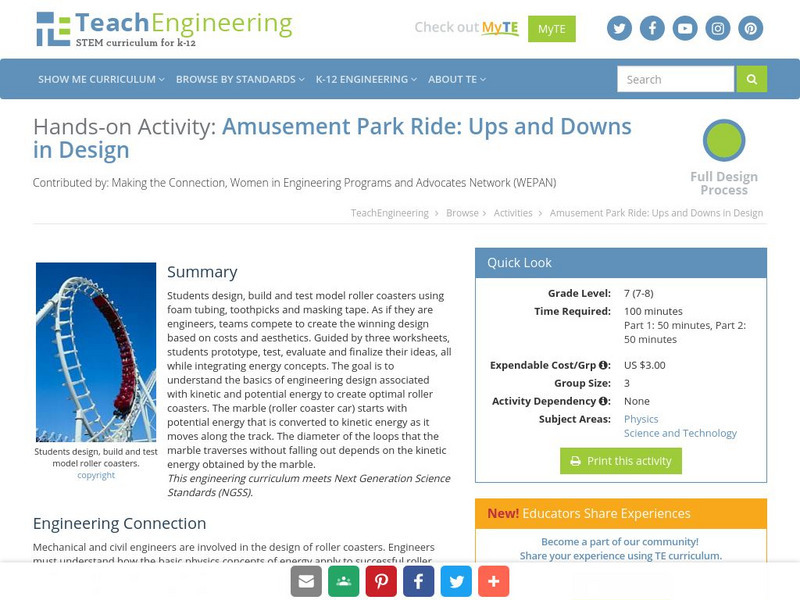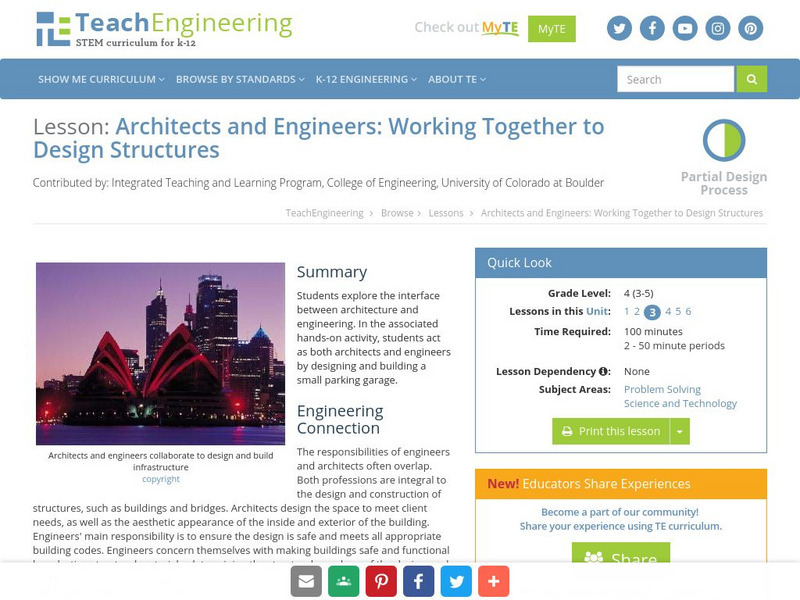Hi, what do you want to do?
PBS
Pbs Learning Media: South Carolina Collection
The PBS South Carolina Collection features a range of digital resources tailored especially for Palmetto State teachers and students. Topics include early education, literacy, African American history, STEM, Common Core, and many more!
Other
Interaction Design Foundation: 5 Stages in the Design Thinking Process
Understanding the five stages of Design Thinking will empower anyone to apply the Design Thinking methods in order to solve complex problems that occur around us. The article stresses that design thinking is by its nature non-linear and...
PBS
Pbs Learning Media: Young Inventors
In this stills collage adapted from the National Science Teachers Association/Craftsman Young Inventors Awards, see several inventions by students in grades 4-7 and read about some of the challenges they faced during the design process.
TryEngineering
Try Engineering: Pollution Patrol
Students will work in teams to design and construct outdoor air pollution detectors from everyday items. They will then test the designs for presence of pollutants in the air and communicate their results to the class.
TryEngineering
Try Engineering: Solar Structures
During this lesson, young scholars will construct a passive solar house from everyday items then explore how the sun's energy is used to heat and cool it.
TeachEngineering
Teach Engineering: Rockets on a Shoestring Budget
In this activity, students revisit the Pop Rockets activity from Lesson 3. This time, however, the design of their pop-rockets will be limited by budgets and supplies. They will get a feel for the limitations of a real engineering...
TeachEngineering
Teach Engineering: Amusement Park Ride: Ups and Downs in Design
This unit has students design and build foam tubing roller coasters. The design process integrates energy concepts as they test and evaluate their designs that address the task as an engineer would. The goal is for students to understand...
TeachEngineering
Teach Engineering: Problem Solving
Lesson explains the seven steps to the problem solving process. Students can practice the process using associated activities.
TeachEngineering
Teach Engineering: Transportation and the Environment
Looking at transportation and the environment, students learn that some human-made creations, such as vehicles, can harm the environment. They also learn about alternative fuels and vehicles designed by engineers to minimize pollution....
TeachEngineering
Teach Engineering: Architects and Engineers
Students explore the interface between architecture and engineering. In the associated hands-on activity, students act as both architects and engineers by designing and building a small parking garage.
TeachEngineering
Teach Engineering: Learn to Build a Rocket in 5 Days or Your Money Back
In this lesson, students discover the entire process that goes into designing a rocket for any customer. In prior lessons, students learned how rockets work, but now they learn what real-world decisions engineers have to make when...
TeachEngineering
Teach Engineering: Pyramid Building: How to Use a Wedge
Students learn how simple machines, including wedges, were used in building both ancient pyramids and present-day skyscrapers. In a hands-on activity, students test a variety of wedges on different materials (wax, soap, clay, foam)....
TeachEngineering
Teach Engineering: Simple Machines and Modern Day Engineering Analogies
Students apply the mechanical advantages and problem-solving capabilities of six types of simple machines (wedge, wheel and axle, lever, inclined plane, screw, pulley) as they discuss modern structures in the spirit of the engineers and...
TeachEngineering
Teach Engineering: Engineering Design Process
This visual is a representation of engineering design process which includes teamwork and design. Students will be able to follow the steps of the design process to strengthen their understanding of open-ended design and emphasize...
PBS
Pbs Learning Media: Testing With Models
In this video segment from Cyberchase, learn about the importance of creating a model as the CyberSquad designs a giant "Trojan Ducky" that will help them enter a fort without being noticed. [4:17]
Other
Developing a New Product: Creating Functional and Non Functional Requirements
Functional requirements are features that are built to serve a product's users. They are pieces of functionality that solve particular problems for users. Non-functional requirements concern the operation of the system, such as technical...
Other
Joining Dots: Why Design Means Compromise
In this blog article, the author talks about some of the trade-offs that must occur during the software design process with reference to an interview with Bill Buxton who was Principle Researcher at Microsoft Research at the time....
PBS
Pbs Learning Media: Engineer a Jetliner
In this interactive lesson, students will experience the engineering design process as an aerospace engineer assigned to design and test an airplane.
PBS
Pbs Learning Media: Higher and Faster
In this interactive lesson, students will explore the social factors, economic factors and engineering innovations that drive higher and faster commercial flights.
Other
Coalition of Oregon School Administrators (Cosa): Design Process [Pdf]
This resource outlines the steps in the design process. It describes problem identification, research, deciding on a solution, making and testing a prototype, communicating the results, and evaluation and redesign.
Other
Interaction Design Foundation: Complex Socio Technical Systems
Complex socio-technical systems are intricate societal and global problems: challenges where designers strive to define human problems, understand the far-reaching implications of these and address them carefully. As they are hard to...















